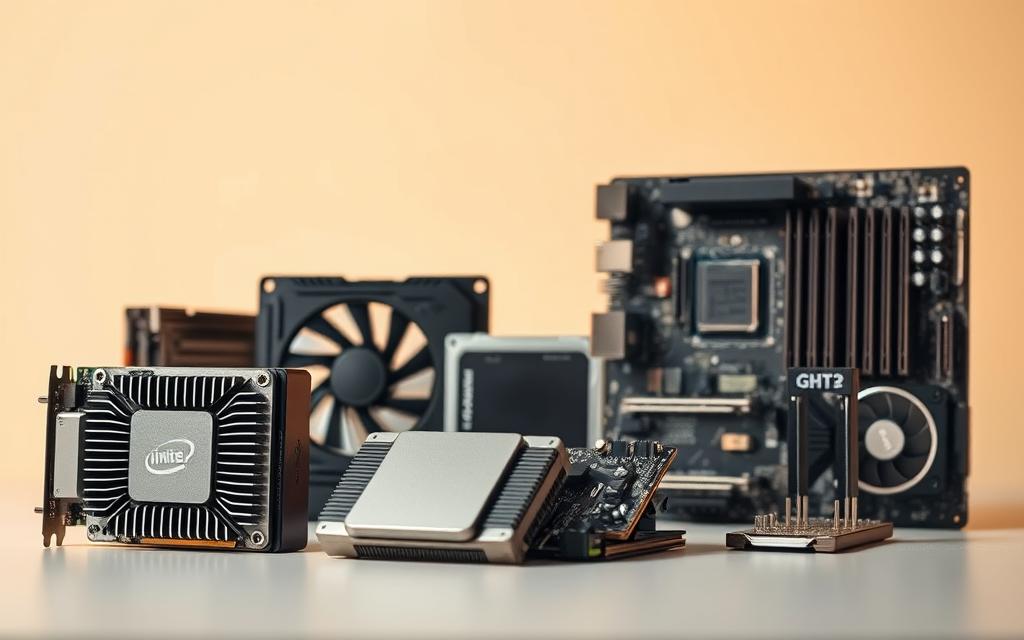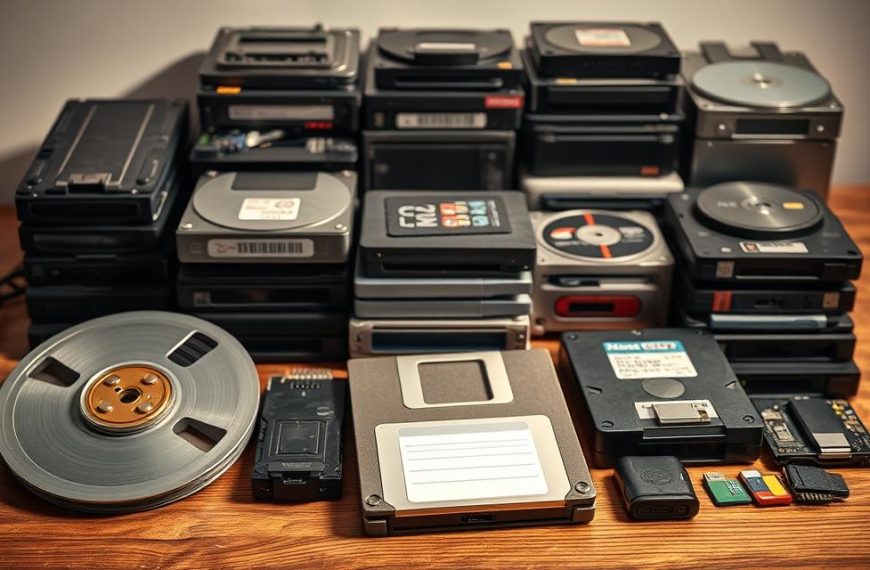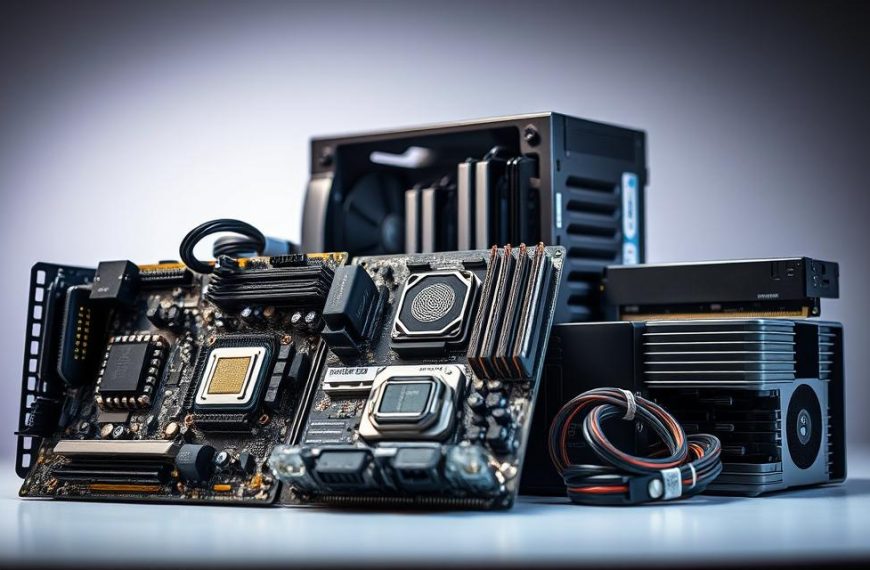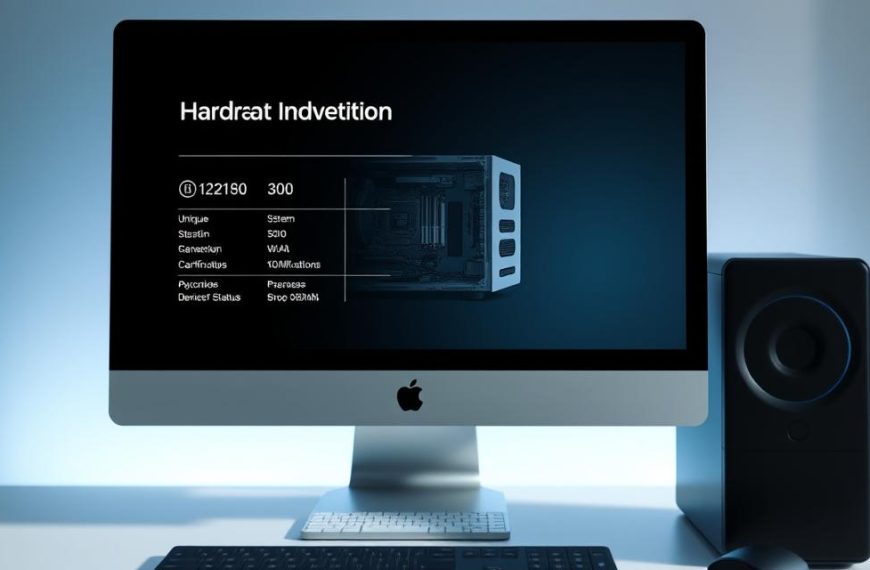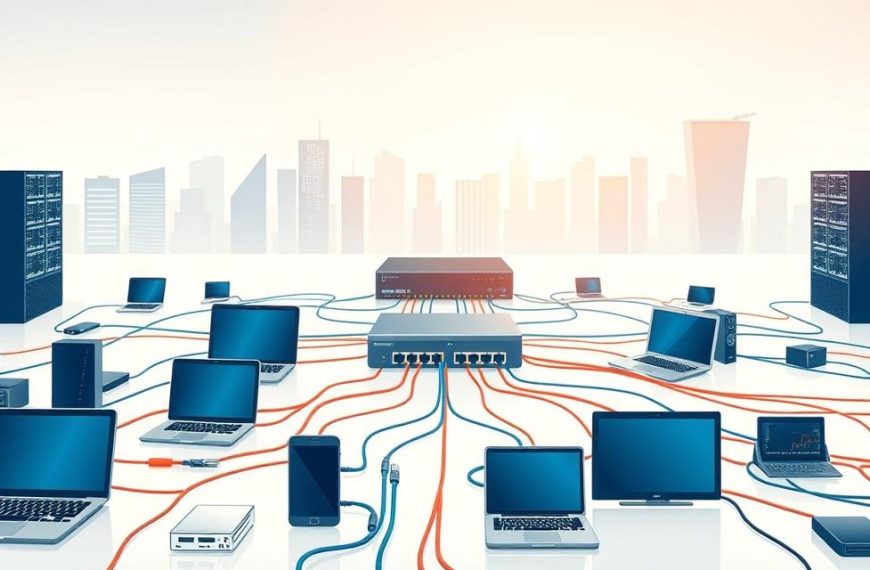Computer hardware is the physical foundation of modern digital tech. It forms the core of every computing device, from small laptops to powerful desktops.
Knowing about computer parts helps you make smart tech choices. Each component plays a key role in how well a system works.
Today’s computers use advanced hardware like multicore processors. These can run at speeds from 1.5GHz to 5GHz.
New Intel chips now mix efficient (E) and performance (P) cores. This shows how quickly computer hardware design is changing.
RAM, SSDs, and built-in GPUs are also moving forward. These parts make our digital experiences more powerful and smooth.
Let’s dive into the world of computer hardware. We’ll look at the key parts that drive tech innovation.
Understanding Computer Hardware Fundamentals
Computer hardware forms the physical core of digital tech. It includes tangible parts that power computing systems. These elements are vital for handling digital data.
From tiny microchips to complex computer system components, hardware processes and stores information. It’s the backbone of our digital world.
What is Computer Hardware?
Computer hardware refers to the physical devices in a computing system. These components fall into two main groups:
- Internal hardware components
- External peripheral devices
Internal components are crucial parts like the CPU, motherboard, RAM, and storage drives. External devices include keyboards, mice, monitors, and printers.
Hardware vs Software: Key Differences
Hardware and software differ in their basic nature. Hardware is the physical, touchable part of a computer system. Software consists of intangible programs that guide these physical components.
| Hardware | Software |
|---|---|
| Physical components | Programmatic instructions |
| Can be physically touched | Intangible digital instructions |
| Requires physical maintenance | Updated through digital downloads |
The Role of Hardware in System Performance
Hardware performance directly affects a computer’s overall efficiency. The quality of computer parts determines processing speed and memory capacity. It also impacts computational capabilities.
Modern computers use advanced hardware tech for sophisticated digital experiences. These improvements constantly push the boundaries of what’s possible.
The synergy between hardware and software creates the technological foundation of our digital world.
Central Processing Unit (CPU): The Brain of Your Computer
The Central Processing Unit (CPU) is the core powerhouse of computer systems. It drives digital operations as the main computational engine. Since 1971, CPUs have evolved from simple calculators to complex units executing billions of instructions per second.
Processor performance relies on several key factors. These include clock speed in gigahertz (GHz), number of cores, cache memory size, and instruction processing abilities.
- Clock speed measured in gigahertz (GHz)
- Number of processor cores
- Cache memory size
- Instruction processing capabilities
Modern CPUs use advanced architectures from leading makers like Intel and AMD. These processors have multiple cores for simultaneous task processing. Multi-core technology is a major leap in CPU design, boosting computational efficiency.
CPU technology has seen remarkable progress over the years. Early single-core processors managed 5,000 equations per second. Now, multi-core chips perform billions of calculations instantly.
Today’s high-performance processors can have up to 64 cores. This shows the incredible advancement in computational capabilities.
The CPU remains the critical component determining a computer’s overall performance and computational potential.
Understanding CPU functions is vital when choosing a computer. It helps make informed decisions about computational needs. This applies to various uses, from web browsing to scientific research and gaming.
What Are the Main Components of a Computer Hardware System
Computer hardware parts are vital for your machine to work. These bits team up to create a smooth computing experience. Each piece has a special job in making your computer run well.
From number-crunching to storing files, every part matters. Let’s look at the key bits that make modern computers tick.
Motherboard: The Central Hub
The motherboard is the heart of your computer. It links all the hardware parts together. This board lets different pieces chat and work as one.
New motherboards can handle lots of setups. They also decide what upgrades you can make later.
- Connects all hardware components
- Enables communication between different parts
- Determines system upgrade potential
RAM: System Memory
RAM stores data your computer is using right now. Gamers often need at least 8GB of RAM. Graphic designers might want 16GB for big jobs.
| RAM Type | Performance | Recommended Usage |
|---|---|---|
| 8GB | Standard | Basic computing, casual gaming |
| 16GB | High | Professional design, advanced gaming |
Storage Devices: HDD and SSD
Storage devices keep your data safe for the long haul. Solid State Drives (SSDs) are faster and tougher than old Hard Disk Drives (HDDs).
- SSDs use NAND flash memory chips
- Faster data access and transfer
- Lower power consumption
Graphics Processing Unit (GPU)
The GPU handles pictures and helps with other tasks too. New GPUs make your whole computer faster, not just the visuals.
GPUs are no longer just for graphics – they’re powerful computational engines.
Essential Peripheral and Connectivity Hardware
Computer peripherals are vital for hardware connectivity. They help users interact with and expand their computing experience. These external devices bridge the gap between users and core system components.
Input devices like keyboards and mice allow precise user interaction. Modern hardware connectivity now includes advanced controllers, touchpads, and specialised gaming input devices. These enhance user engagement across different computing environments.
Network interface cards (NICs) support both wired Ethernet and wireless Wi-Fi connections. The global market for peripheral devices is set to reach $200 billion by 2025. This reflects the growing importance of these technological extensions in modern computing systems.
Audio hardware systems include integrated and dedicated sound cards. They provide sophisticated sound processing capabilities. Professional users often choose dedicated sound cards for superior audio quality and advanced features.
Input Devices and Their Functions
Input devices turn user actions into digital signals for computers to process. Keyboards and optical mice are still standard. However, new tech has brought in touchscreens, graphic tablets, and motion-sensing controllers.
Output Devices Overview
Output devices change digital information into formats humans can understand. High-resolution monitors, precision printers, and immersive speaker systems are key output technologies. They turn raw digital data into meaningful visual and auditory experiences.
Networking Components
Networking hardware allows smooth digital communication. Routers, modems, and network interface cards enable internet connectivity and data exchange. Wireless technologies are becoming more common in modern computing environments.
Audio Hardware Systems
Audio hardware has evolved from basic sound reproduction to complex multimedia experiences. Integrated and dedicated sound cards process intricate audio signals. They support everything from professional music production to immersive gaming soundscapes.

